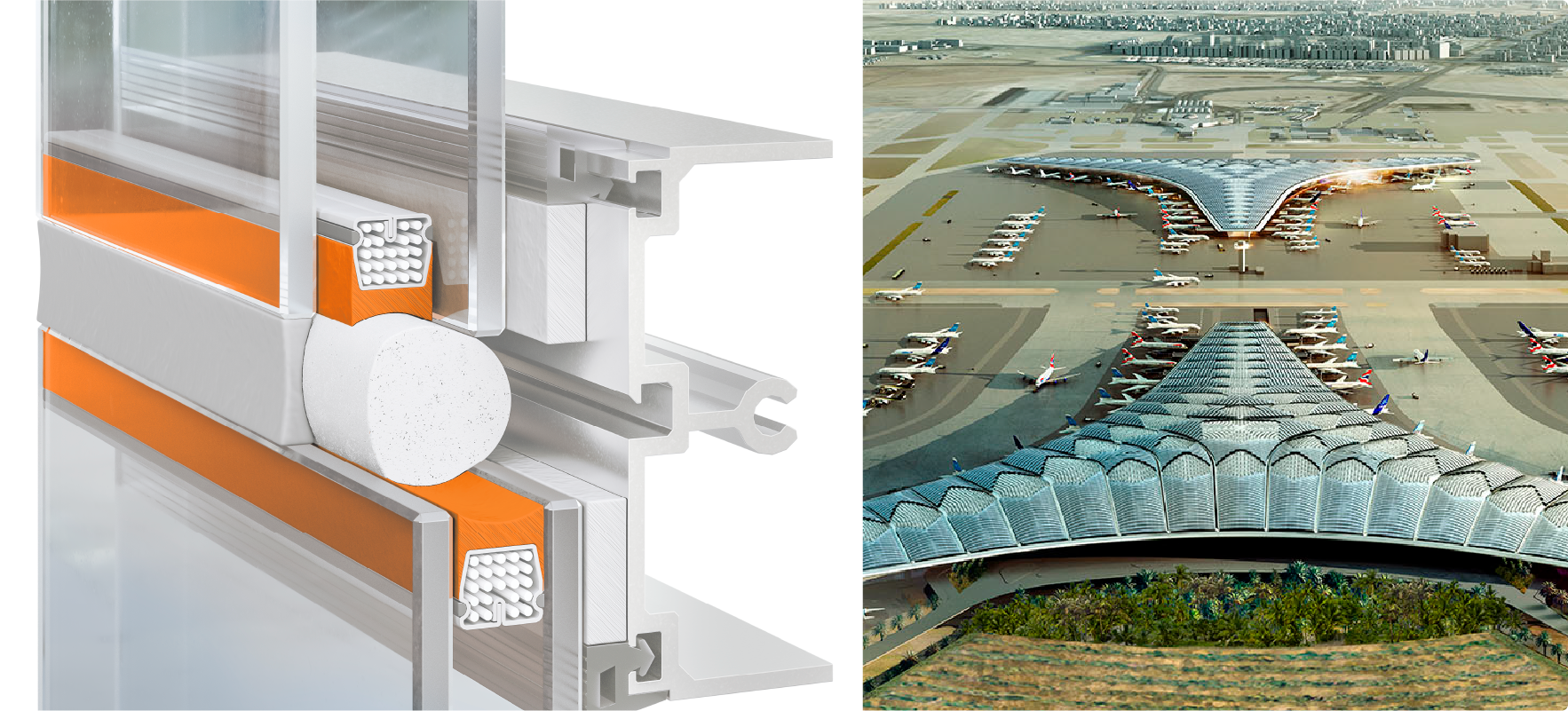실리콘 실란트는 전 세계 모든 종류의 건물에서 볼 수 있는 글레이징 시스템의 필수 부품입니다. 올바른 실란트를 선택하는 방법은 무엇일까요?
작년에 모멘티브 내셔널 구조용 글레이징 매니저인 더그 워커는 USGlass 매거진의 기사에 소개된 바 있습니다.
이 블로그에서는 실리콘 실란트가 글레이징에 사용되는 방법과 이유, 단열 유리, 구조용 글레이징 및 웨더실링 용도로 실리콘 실란트를 선택할 때 고려해야 할 요소를 살펴보면서 이 주제를 확장합니다.
건설 산업에서 유리 용도에 사용되는 실리콘 실란트에는 크게 네 가지 유형이 있습니다: ↪f_200D↩↪f_200D↩
↪f_200D↩
EdgeSil™ 단열 유리 실란트와 같은 실리콘 실란트는 단열 유리 유닛(IGU) 가장자리 실의 보조 실란트로 사용되어 유리 라이트와 스페이서를 서로 접착하고 공기 또는 가스로 채워진 단열 유닛의 무결성을 지원합니다.

울트라글레이즈™ 구조용 실리콘 글레이징 실란트와 같은 실란트는 유리 커튼월, 창문 벽, 유리 파사드 및 보호용 글레이징 시스템에서 강력하고 내구성 있는 접착력을 만드는 데 사용됩니다. 이 실란트는 극한의 날씨를 차단하는 동시에 유리와 기판 사이에 탄력적인 결합력을 제공합니다.

실프루프 웨더실 실란트와 같은 웨더실 실란트는 창문 주변의 공기 및 물 유입을 방지하고 외부 요소를 차단하는 데 사용됩니다. 또한 유리를 프레임에 고정하는 강력한 방수 밀봉을 제공하는 데 사용됩니다.

RapidStrength™ 및 SilGlaze™ II 주거용 글레이징 실란트는 주택용 내후성 창문 및 도어 시스템을 만드는 데 사용됩니다. 다양한 백베딩, 실링 및 가구 제작에 사용됩니다.

실리콘은 다음과 같은 여러 가지 이유로 다양한 글레이징 용도로 사용됩니다:
소니의 실리콘 실란트 포트폴리오는 온도, 날씨, 자외선 노출에 대한 내성을 갖추고 있어 오래 지속되는 성능을 제공합니다.
한번 도포하면 수십 년 동안 안전하고 유연한 결합을 유지하며 극한의 온도, 자외선, 비, 눈, 바람에도 강도와 탄성의 변화가 거의 없는 것으로 입증되었습니다(30년간의 실제 테스트를 통해 이를 입증했습니다!).
이를 통해 글레이징 시스템과 건물이 오랜 시간 동안 지속될 수 있도록 보장합니다.
실리콘 실란트는 화학적 유사성 덕분에 유리에 매우 잘 접착됩니다. 따라서 유리와 기판 사이에 단단하고 매끄러운 밀봉을 만들어 공기와 물의 침투를 방지하면서 모든 것을 안전하게 보호하는 데 적합합니다.
대부분의 글레이징용 실리콘 실란트는 대부분의 피착재에 프라이머 없이 접착되므로 프라이머가 필요한 다른 실란트에 비해 제조 및 도포 공정의 모든 단계에서 시간과 노력을 절약할 수 있습니다.
건물, 특히 고층 건물은 바람에 많이 움직입니다. 실리콘 실란트는 이를 수용하기 위해 시간이 지나도 신축성과 유연성을 유지할 수 있어야 합니다. 헨켈의 실리콘 실란트 제품군은 신축성과 인열 저항성이 뛰어나 움직임을 수용할 수 있습니다. 이는 유리 패널과 건물 자체의 구조를 보호하는 데 도움이 됩니다.
실리콘 실란트는 자연재해, 허리케인 수준의 바람, 기물 파손 또는 폭탄 폭발을 견딜 수 있도록 설계된 보호용 글레이징 시스템에 특히 적합합니다.
이러한 상황에서 건물 거주자에게 가장 큰 위험 중 하나는 유리입니다. 유리가 프레임에서 날아가면 파편이 건물 안에 있는 사람들에게 치명적인 부상을 입힐 수 있습니다.
이를 방지하기 위해 보호용 글레이징 시스템은 프레임에서 유리가 찢어지는 것을 방지하여 이러한 위험을 줄이도록 설계되었습니다.
울트라글레이즈 실리콘 구조용 글레이징 실란트는 이를 위해 높은 인장 강도, 높은 인열 강도 및 높은 연신율의 적절한 조합을 제공합니다. 이를 통해 찢어지지 않고 관련 힘을 견딜 수 있습니다. 대신 실란트는 움직임을 수용하여 에너지를 효과적으로 흡수하고 발산하는 데 도움이 됩니다.
건축가들이 초고층 및 초대형 고층 건물에서 탁 트인 도시 전망을 확보하기 위해 점보 유리를 사용하는 것이 현대 글로벌 건축의 가장 큰 트렌드 중 하나입니다. 목표는 더 많은 유리와 더 적은 금속으로 구조물을 만드는 것입니다.
문제는 건물의 높이가 높아질수록 풍압이 증가하고 유리 패널이 커지면 일반적으로 더 큰 실리콘 바이트와 더 넓은 멀리언이 필요하며, 이는 설계 비전에 직접적으로 반한다는 것입니다.
이 문제를 극복하려면 강도, 유연성 및 내열성이 향상된 실리콘 실란트를 사용해야 합니다. 울트라글레이즈 SSG4600 실란트는 인장 설계 강도가 30psi(210kPa)에 달합니다.
블로그를 확인하세요. 수퍼타워에서 메가타워까지 - 실리콘 기술로 구조용 글레이징의 경계를 넓히다 에서 자세히 알아보세요.

다음 프로젝트에 적합한 실리콘 글레이징과 유리 실란트를 선택하는 것은 설계 단계부터 시작됩니다. 건축 엔지니어는 올바른 솔루션을 선택하고 실리콘 접착을 위한 접착제 물린 크기와 형상 등을 결정할 책임이 있습니다.
당사는 계약업체, 건축가 및 건설 엔지니어와 긴밀히 협력하여 접착력, 호환성 및 성능 검토를 제공하여 올바른 실란트를 사용할 수 있도록 합니다.
이를 결정할 때 가장 중요한 요소 중 하나는 접착 성능이며, 특히 단열 유리 및 구조용 글레이징 애플리케이션에서 더욱 그렇습니다. 이를 결정하는 데는 접착 성능에 영향을 줄 수 있는 유리의 기질과 코팅 등 몇 가지 요소가 영향을 미칩니다.
일반적으로 이 결정 과정에는 데이터시트를 통한 제품 선택 또는 기술 팀원과의 상담이 포함될 수 있습니다. 필요한 경우 제품이 예상대로 작동하는지 확인하기 위해 실험실 테스트와 현장 테스트를 진행할 수 있습니다.
실리콘 실란트에 결함이 있는 경우는 매우 드물며, 단열 유리 또는 구조용 글레이징 성능의 실패는 잘못된 시스템 설계, 잘못된 제품 선택, 테스트 부족, 부적절한 표면 처리 또는 적용 오류로 인해 발생하는 경우가 많습니다.
모멘티브의 전국 구조용 글레이징 매니저 더그 워커는 이렇게 설명합니다:
"대부분의 제품과 마찬가지로 올바른 제품을 선택하고, 올바르게 보관하고, 유통기한 내에 사용해야 합니다!"
당사는 글레이징 애플리케이션을 위한 다양한 고성능 실리콘 실란트를 제공합니다:
실리콘 빌딩 전문가에게 문의하여 필요에 맞는 전문가 조언을 받거나 현지 영업 담당자와 프로젝트에 대해 논의하여 최상의 솔루션과 인사이트를 알아보세요.
독점적인 업계 인사이트, 제품 뉴스, 웨비나 및 이벤트를 통해 최신 소식을 받아보세요.
